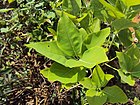Note: This is a project under development. The articles on this wiki are just being initiated and broadly incomplete. You can Help creating new pages.
Difference between revisions of "Litsea chinensis - Medāsakaḥ"
(→Photo Gallery) |
(→Photo Gallery) |
||
| Line 60: | Line 60: | ||
<gallery class="left" caption="" widths="140px" heights="140px"> | <gallery class="left" caption="" widths="140px" heights="140px"> | ||
File:Litsea glutinosa 8.JPG|Leaves | File:Litsea glutinosa 8.JPG|Leaves | ||
| − | File:Litsea glutinosa (Lour.) C. B. Rob. (3).|Leaves | + | File:Litsea glutinosa (Lour.) C. B. Rob. (3).jpg|Leaves |
File:Litsea glutinosa (Lour.) C. B. Rob.jpg|Buds | File:Litsea glutinosa (Lour.) C. B. Rob.jpg|Buds | ||
Revision as of 15:49, 24 May 2019
Medāsakaḥ consists of stem bark of Litsea chinensis Lam. syn. L. glutinosa (Lour.) C.B. Robins, L. sebifera Pers. (Fam. Lauraceae), an evergreen shrub or tree, upto 25 m in height and about 1.5 m in girth with a clean bole, found throughout India, ascending upto an altitude of 1350 m in outer Himalayas.
Contents
- 1 Uses
- 2 Parts Used
- 3 Chemical Composition
- 4 Common names
- 5 Properties
- 6 Habit
- 7 Identification
- 8 List of Ayurvedic medicine in which the herb is used
- 9 Where to get the saplings
- 10 Mode of Propagation
- 11 How to plant/cultivate
- 12 Commonly seen growing in areas
- 13 Photo Gallery
- 14 References
- 15 External Links
Uses
Cough, Backache, Drying of skin, Inflammation of joints, Bleeding piles, Diarrhea, Tapeworms, Wounds.
Parts Used
Bark.
Chemical Composition
Alkaloids (Laurotetaline, actinodaphine, boldine, norboldine, sebiferine and litseferine).[1]
Common names
| Language | Common name |
|---|---|
| Kannada | |
| Hindi | Maida Lakdee |
| Malayalam | |
| Tamil | Medalakavi |
| Telugu | Meda |
| Marathi | NA |
| Gujarathi | NA |
| Punjabi | NA |
| Kashmiri | NA |
| Sanskrit | Medāsakaḥ |
| English |
Properties
Reference: Dravya - Substance, Rasa - Taste, Guna - Qualities, Veerya - Potency, Vipaka - Post-digesion effect, Karma - Pharmacological activity, Prabhava - Therepeutics.
Dravya
Rasa
Tikta, Kaṭu, Kaṣāya
Guna
Laghu, Snigdha
Veerya
Uṣṇa
Vipaka
Kaṭu
Karma
Vātahara, Kaphahara, Dīpana, Stambhana, Bhagnaprasādaka
Prabhava
Habit
Identification
Leaf
| Kind | Shape | Feature |
|---|---|---|
| Simple | Alternate | Leaves simple, pilose when young; lamina 6-23.5 x 3-10 cm, elliptic, elliptic-oblong or obovate, base acute, apex acute, obtuse or acuminate, margin entire, glabrous above, grey-pubescent beneath, chartaceous; lateral nerves 7-12 pairs, pinnate, prominent, intercostae reticulate. |
Flower
| Type | Size | Color and composition | Stamen | More information |
|---|---|---|---|---|
| Unisexual | 5-6mm long | yellow | 9-12 | In many flowered umbels; peduncles upto 5 mm long, slender, densely pilose; perianth short; tube silky, funnel shaped, segments 0; stamens 9-12, all fertile, in 4 rows; filaments to 2 mm, very hairy; fourth series glandular, glands sessile, orbicular; ovary half inferior, 1 mm long; style 1.5 mm, stigma dilated, irregularly lobed; staminodes 9-12, to 2.5 mm. |
Fruit
| Type | Size | Mass | Appearance | Seeds | More information |
|---|---|---|---|---|---|
| Berry | 5-6 mm | depressed, globose, purple, on flat disc. |
Other features
List of Ayurvedic medicine in which the herb is used
Where to get the saplings
Mode of Propagation
How to plant/cultivate
Commonly seen growing in areas
[[:Category:Herbs that are commonly seen in the region of |]], [[:Category:Herbs that are commonly seen in the region of |]].
Photo Gallery
References
External Links
- Ayurvedic Herbs known to be helpful to treat Cough
- Ayurvedic Herbs known to be helpful to treat Backache
- Ayurvedic Herbs known to be helpful to treat Drying of skin
- Ayurvedic Herbs known to be helpful to treat Inflammation of joints
- Ayurvedic Herbs known to be helpful to treat Bleeding piles
- Ayurvedic Herbs known to be helpful to treat Diarrhea
- Ayurvedic Herbs known to be helpful to treat Tapeworms
- Ayurvedic Herbs known to be helpful to treat Wounds
- Herbs with Bark used in medicine
- Herbs with common name in Hindi
- Herbs with common name in Tamil
- Herbs with common name in Telugu
- Herbs with common name in Sanskrit
- Habit - Small tree
- Index of Plants which can be propagated by Seeds
- Herbs that are commonly seen in the region of
- Herbs
- Ayurvedic herbs that don't have flower, fruit and leaf photos
- Ayurvedic herbs that don't have seed photos



